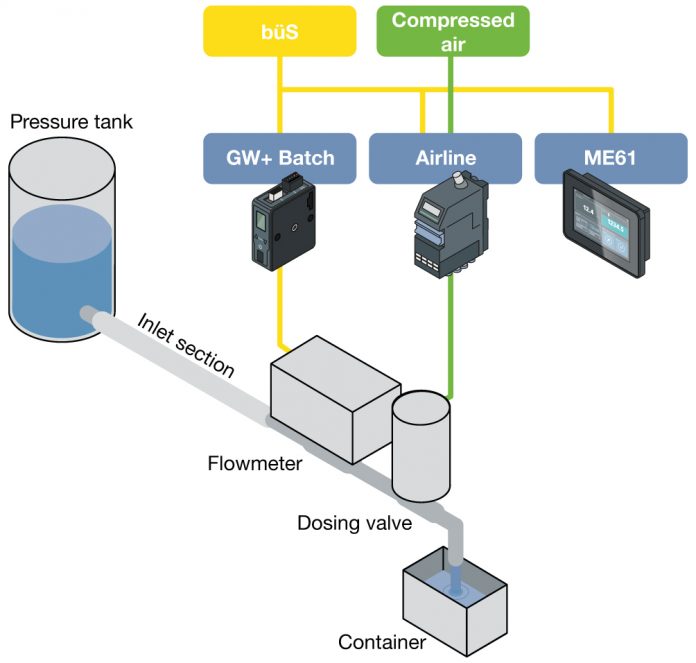Batch manufacturing offers several advantages for producers of high-quality end products, and it is common in the pharmaceutical, food and beverage sectors. Quality control is of paramount importance, while achieving cost-effectiveness comes a close second. In these processes, the design of the batch sizing control system can have a significant impact on the quality of the end product.
Kieran Bennett, Industry Manager, Food, Beverage, Chemical & Petrochemical at Bürkert looks at the importance of process accuracy and how it can be achieved.
The essence of batch control is the measurement and transfer of a variety of fluids to one location where they can be processed and moved on to the next production phase. Measuring and verifying flow volumes is key to establishing a reliable and repeatable process where all of the ingredients are measured precisely.
Hardware requirements
Batch sizing control requires four essential components: the batch controller, communicator software, valves and a flow sensor. In addition, there are a few optional extras, such as operator displays, input/output modules and cabinets that collectively complete the installation.
Batch control is based on a simple principle where a valve opens to allow a certain volume of liquid to flow before being closed. The opening time for the valve is managed by the flow controller and a flowmeter is used to measure the actual volume dispensed. A feedback loop can improve the accuracy of the process by comparing the theoretical volume with the measured quantity.
In hygienic applications, such as those in food and beverage or pharmaceutical settings, there is an additional requirement for all the materials and designs to be optimised for cleanliness. Hygienic designs must be specialised for clean/steam-in-place (CIP/SIP) processes; the requirements mean non-contact flow measurement designs using ultrasonics, electro-magnetic and Coriolis technologies have come to the fore.
Dealing with challenging fluids
However, these designs have drawbacks which can make them unsuitable for some applications. Many of the fluids involved in the pharmaceutical or food and beverage industries present challenges for conventional flow meters, with many requiring a conductive fluid with laminar flow, free from entrained gases.
Bürkert’s revolutionary flowmeter uses surface acoustic waves (SAW) technology to overcome these traditional obstacles. Manufactured from high quality stainless steel and with no internal restrictions, the FLOWave sensor can address many of the shortcomings of other flow measurement devices in the hygienic sector.
Having proven its performance and accuracy in many applications, the FLOWave is also a vital part of precision batch mixing control systems with better than 1% variation. Working in combination with other Bürkert hardware, including process valves, batch controllers and a touchscreen, the process of designing and commissioning a batch sizing control system is greatly simplified.
Set up procedures
One of the major challenges with batch sizing is setting up the equipment. With so many variables in an installation, it can be a complex and time-consuming process to manually install all the configurations and ensure that all the components are properly set up and working in harmony. However, Bürkert has designed its components to utilise digital communications, enabling them to recognise each other and complete a large part of the configuration automatically. The touchscreen is integral to this procedure, walking the operator through the remaining steps for a simplified process.
Once the system is operational, a crucial part of batch sizing is the ability to compensate for changes in the system that affect the quantity being dispensed. Raw materials can be expensive so over-dosing, even by a small percentage, soon adds up to significant costs that could be avoided. This is especially true in the pharmaceutical industry, where active ingredients and water for injection (WFI) all have significant costs – so accuracy in this market is crucial.
Continuous accuracy
Burkert’s system uses a feedback loop that measures the dispensed volume and adjusts the timing of the valve accordingly. For example, if the storage vessel for the dispensed liquid does not have pressure compensation, then as more fluid is used, the pressure will drop, which will result in the dosed volumes reducing.
Bürkert’s system utilises the precision measurements from the FLOWave to assess the accuracy of the batch size compared to the theoretical volume. This information is used in a continuous feedback loop, to auto-correct the opening time of the valve to compensate for changes in the system and assure continued accuracy.
To enhance the system, Bürkert’s solution uses a 7” touchscreen, located at the batching station, to allow the operator to pause, stop and start the process. The seamless communication between all the components ensures that both configuration and operation run smoothly.
This setup, which has already proven itself with applications in the food and beverage sector, is widening the functionality of the FLOWave and providing additional opportunities for manufacturers to make their batching processes more accurate and cost-effective.
To see how FLOWave works in a batch control system, take a look at this video
For more information about how FLOWave’s contactless measurement can support your batch process, visit https://www.burkert.co.uk/en/more-about/the-future-of-contactless-flow-measurement-type-8098-flowave




